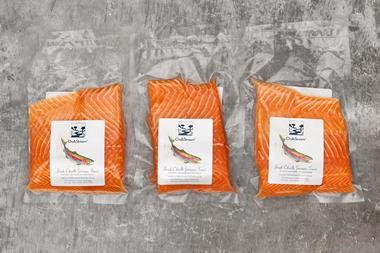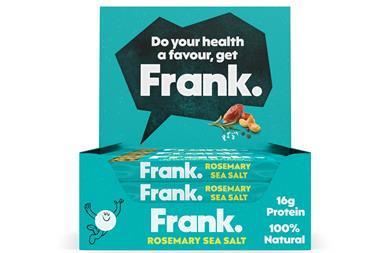Basmati is gaining on long grain as consumers seek sophistication, while noodles are striving to offer more. Sean McAllister reports
The rice market is expanding like never before as consumers strive to recreate the restaurant experience at home.
This has helped the rice market grow to £198m, 4.5% up on the previous year [Taylor Nelson Sofres July 2002]. Own label products still dominate with 65% of the total market but are being eroded by the brands through promotional activity and innovation.
Despite own label's prominence there has been a resurgence in brands. Westmill, known mostly for own label, has linked up with Patak's to launch an easy-cook and traditional basmati and a range of microwaveable rices under the Patak's brand. It has also re-introduced its leading ethnic brand Tolly Boy to Kwik Save.
Uncle Ben's still leads the pack with a 16.2% share of the rice market. Tilda is hot on its heels with 11.3%. But what Tilda lacks in terms of sales, it makes up for in basmati, where it dominates with a 24% share of the market.
Basmati has been one of the big growth areas in rice  up 19.5% in the past year  and is fast catching up with long grain, reaching 28.3% of the market. "This growth has been driven by strong promotional activity on both own label and branded," says Westmill Foods sales and marketing director Gavin Bowie. "This has led to the price difference between basmati and other types being cut and has encouraged trade-up."
Basmati's positive image places it at the premium end of the category. Aside from its aroma, it is easier to cook than long grain. It also matures with age which, according to Veetee, encourages sales of larger packs. It has seen a 29% rise in sales of its 10kg packs of Supreme Basmati rice and 14% growth in the 5kg jars.
Elaine Underwood, chief executive of Latina Brands, says sales of rice should continue to grow if its health benefits are better understood. "We eat too much pasta and when coupled with the consumption of bread we overdose on wheat. Rice is also low in fat."
Consumers' willingness to experiment in the kitchen has had a dampening effect on savoury rice. Sales remained static over the last year, although overall savoury rice is still worth nearly £34m, 22.1% of the total rice market.
Batchelors holds 43% of this market and has seen growth of 5.5% year-on-year. In contrast, own label sales have dipped 4%, although it still accounts for 44% of the market.
The introduction of microwaveable rice should help change rice's stigma of being hard to cook. Introduced three years ago, the sector is now worth £18.4m, a rise of 141.5% on last year.
These new rices are also driving incremental sales to the category as a whole. "Microwave rices are not substituting dry rice. They are bringing new people to the market," says Tilda's brand manager Deborah Batten.
Uncle Ben's, which first marketed microwaveable, is still brand leader with a 73% share but Tilda, with 18% share, has been very active in the past year. It has launched eight varieties of its Rizazz rice since May 2001.
Patak's entered the market three months ago and with Tilda putting £2m into ads for Rizazz, the category looks set for another boost.
Tilda has also launched five sauces under the Rizazz name. It is a strategy that is likely to increase sales of rice. As Bowie explains: "Consumers tend firstly to select their sauce then choose an accompaniment such as rice. That combined with the tendency for consumers to shop across one brand will mean that branded sauces and rices are likely to be purchased together. This has been a major factor in our partnership with Patak's."
Amoy has a similar strategy with a range of Straight to Wok sauces and vegetables designed to complement Amoy's New Noodles, which are sold ready cooked.
Amoy has had a good year with sales up 11.7% on last year but overall the market for traditional noodles has remained stable. According to Jo Wallace, product manager for Amoy, the market shouldn't be flat. "Consumers are much more willing to try new foods especially those seen to be healthy such as noodles. The market is at the stage pasta was 20 years ago and what it needs is more innovation as this drives the market, not promotions."
Amoy was the first to introduce soft noodles with the New Noodles range, now extended to include Udon noodles, a bigger noodle popular in China. It also launched two noodle accompaniments at the start of the year, Lao Mein Noodle Sauce and Noodle Salad Sauce.
These new products have been introduced in an attempt to increase the frequency of meals that include noodles. "Currently noodles are not seen as an everyday food like pasta," says Wallace. "Consumers need a greater variety of noodles and noodle dishes."
Blue Dragon has 31 types of noodle and has made large distribution gains this year that have helped sales rise by over 55%. It has launched organic and Szechuan noodles but its biggest success over the past year has come from its rice noodles, sales of which are up 52.9%.
Brand leader Sharwood's still sees potential in traditional noodles, despite sales falling 5.3% year-on-year. It found that noodles had a household penetration of 24% whereas the penetration of oriental sauces was 45% Â a gap equating to five million households. It's exploring initiatives to grow eating occasions.
{{FOCUS ON }}
The rice market is expanding like never before as consumers strive to recreate the restaurant experience at home.
This has helped the rice market grow to £198m, 4.5% up on the previous year [Taylor Nelson Sofres July 2002]. Own label products still dominate with 65% of the total market but are being eroded by the brands through promotional activity and innovation.
Despite own label's prominence there has been a resurgence in brands. Westmill, known mostly for own label, has linked up with Patak's to launch an easy-cook and traditional basmati and a range of microwaveable rices under the Patak's brand. It has also re-introduced its leading ethnic brand Tolly Boy to Kwik Save.
Uncle Ben's still leads the pack with a 16.2% share of the rice market. Tilda is hot on its heels with 11.3%. But what Tilda lacks in terms of sales, it makes up for in basmati, where it dominates with a 24% share of the market.
Basmati has been one of the big growth areas in rice  up 19.5% in the past year  and is fast catching up with long grain, reaching 28.3% of the market. "This growth has been driven by strong promotional activity on both own label and branded," says Westmill Foods sales and marketing director Gavin Bowie. "This has led to the price difference between basmati and other types being cut and has encouraged trade-up."
Basmati's positive image places it at the premium end of the category. Aside from its aroma, it is easier to cook than long grain. It also matures with age which, according to Veetee, encourages sales of larger packs. It has seen a 29% rise in sales of its 10kg packs of Supreme Basmati rice and 14% growth in the 5kg jars.
Elaine Underwood, chief executive of Latina Brands, says sales of rice should continue to grow if its health benefits are better understood. "We eat too much pasta and when coupled with the consumption of bread we overdose on wheat. Rice is also low in fat."
Consumers' willingness to experiment in the kitchen has had a dampening effect on savoury rice. Sales remained static over the last year, although overall savoury rice is still worth nearly £34m, 22.1% of the total rice market.
Batchelors holds 43% of this market and has seen growth of 5.5% year-on-year. In contrast, own label sales have dipped 4%, although it still accounts for 44% of the market.
The introduction of microwaveable rice should help change rice's stigma of being hard to cook. Introduced three years ago, the sector is now worth £18.4m, a rise of 141.5% on last year.
These new rices are also driving incremental sales to the category as a whole. "Microwave rices are not substituting dry rice. They are bringing new people to the market," says Tilda's brand manager Deborah Batten.
Uncle Ben's, which first marketed microwaveable, is still brand leader with a 73% share but Tilda, with 18% share, has been very active in the past year. It has launched eight varieties of its Rizazz rice since May 2001.
Patak's entered the market three months ago and with Tilda putting £2m into ads for Rizazz, the category looks set for another boost.
Tilda has also launched five sauces under the Rizazz name. It is a strategy that is likely to increase sales of rice. As Bowie explains: "Consumers tend firstly to select their sauce then choose an accompaniment such as rice. That combined with the tendency for consumers to shop across one brand will mean that branded sauces and rices are likely to be purchased together. This has been a major factor in our partnership with Patak's."
Amoy has a similar strategy with a range of Straight to Wok sauces and vegetables designed to complement Amoy's New Noodles, which are sold ready cooked.
Amoy has had a good year with sales up 11.7% on last year but overall the market for traditional noodles has remained stable. According to Jo Wallace, product manager for Amoy, the market shouldn't be flat. "Consumers are much more willing to try new foods especially those seen to be healthy such as noodles. The market is at the stage pasta was 20 years ago and what it needs is more innovation as this drives the market, not promotions."
Amoy was the first to introduce soft noodles with the New Noodles range, now extended to include Udon noodles, a bigger noodle popular in China. It also launched two noodle accompaniments at the start of the year, Lao Mein Noodle Sauce and Noodle Salad Sauce.
These new products have been introduced in an attempt to increase the frequency of meals that include noodles. "Currently noodles are not seen as an everyday food like pasta," says Wallace. "Consumers need a greater variety of noodles and noodle dishes."
Blue Dragon has 31 types of noodle and has made large distribution gains this year that have helped sales rise by over 55%. It has launched organic and Szechuan noodles but its biggest success over the past year has come from its rice noodles, sales of which are up 52.9%.
Brand leader Sharwood's still sees potential in traditional noodles, despite sales falling 5.3% year-on-year. It found that noodles had a household penetration of 24% whereas the penetration of oriental sauces was 45% Â a gap equating to five million households. It's exploring initiatives to grow eating occasions.
{{FOCUS ON }}















No comments yet